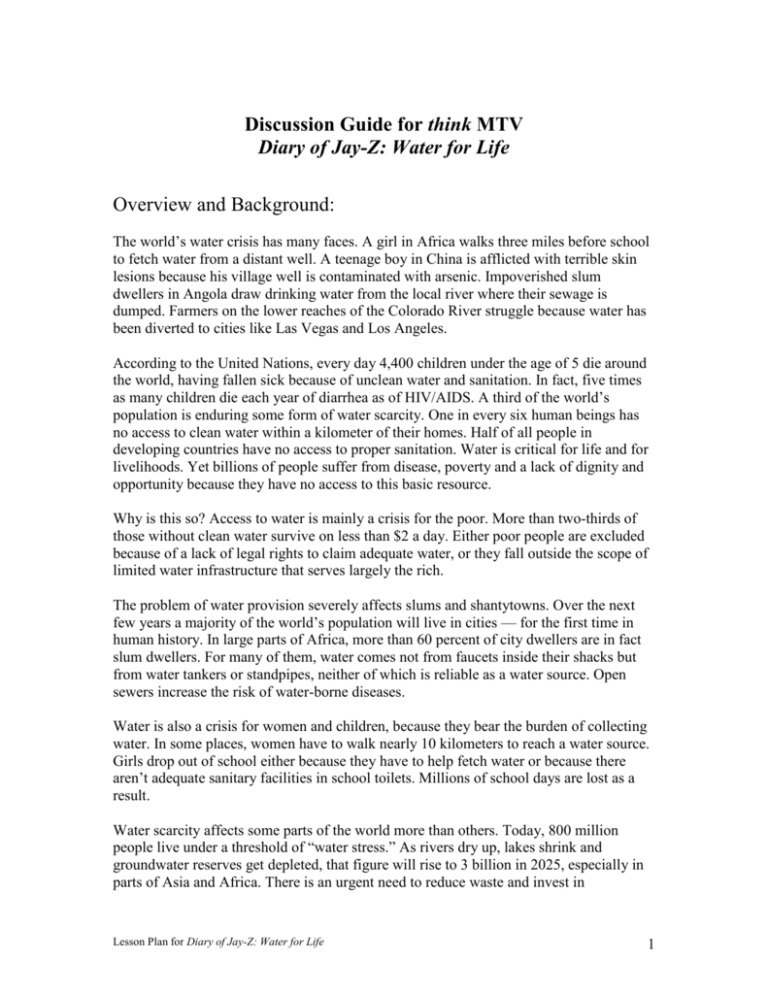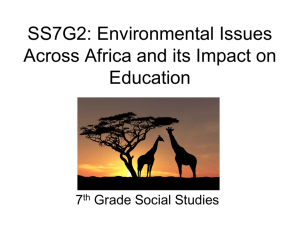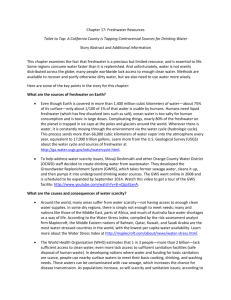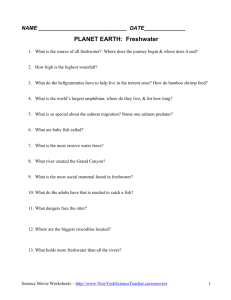Discussion Guide for think MTV
advertisement

Discussion Guide for think MTV Diary of Jay-Z: Water for Life Overview and Background: The world’s water crisis has many faces. A girl in Africa walks three miles before school to fetch water from a distant well. A teenage boy in China is afflicted with terrible skin lesions because his village well is contaminated with arsenic. Impoverished slum dwellers in Angola draw drinking water from the local river where their sewage is dumped. Farmers on the lower reaches of the Colorado River struggle because water has been diverted to cities like Las Vegas and Los Angeles. According to the United Nations, every day 4,400 children under the age of 5 die around the world, having fallen sick because of unclean water and sanitation. In fact, five times as many children die each year of diarrhea as of HIV/AIDS. A third of the world’s population is enduring some form of water scarcity. One in every six human beings has no access to clean water within a kilometer of their homes. Half of all people in developing countries have no access to proper sanitation. Water is critical for life and for livelihoods. Yet billions of people suffer from disease, poverty and a lack of dignity and opportunity because they have no access to this basic resource. Why is this so? Access to water is mainly a crisis for the poor. More than two-thirds of those without clean water survive on less than $2 a day. Either poor people are excluded because of a lack of legal rights to claim adequate water, or they fall outside the scope of limited water infrastructure that serves largely the rich. The problem of water provision severely affects slums and shantytowns. Over the next few years a majority of the world’s population will live in cities — for the first time in human history. In large parts of Africa, more than 60 percent of city dwellers are in fact slum dwellers. For many of them, water comes not from faucets inside their shacks but from water tankers or standpipes, neither of which is reliable as a water source. Open sewers increase the risk of water-borne diseases. Water is also a crisis for women and children, because they bear the burden of collecting water. In some places, women have to walk nearly 10 kilometers to reach a water source. Girls drop out of school either because they have to help fetch water or because there aren’t adequate sanitary facilities in school toilets. Millions of school days are lost as a result. Water scarcity affects some parts of the world more than others. Today, 800 million people live under a threshold of “water stress.” As rivers dry up, lakes shrink and groundwater reserves get depleted, that figure will rise to 3 billion in 2025, especially in parts of Asia and Africa. There is an urgent need to reduce waste and invest in Lesson Plan for Diary of Jay-Z: Water for Life 1 infrastructure to “harvest” rainwater or increase storage. Most water use is in agriculture. Farming uses up to 70 times more water than is used for cooking and washing. Many countries have to import more than half their food needs because they do not have enough water to grow more food. If we do not change the way we use water, the amount needed for a rapidly growing world population will double in the next 50 years. Corruption makes responding to the problem of scarcity more difficult. Up to 40 percent of water is lost to water leakages in pipes and canals, one of the main causes of which is illegal tapping. The increase in the cost of water, as a result, affects the poor more than others. But the water crisis hits cities in the rich world as well — Houston and Sydney, for example, are using more water than is replenished. Australia is the world’s driest continent, where increasing salinity in water is threatening agriculture. Large parts of Europe are affected by recurring droughts. Global warming is another threat. It will be responsible for declining rainfall in some regions, glacial melt in others, and rising sea levels. Other natural disasters occur with more sudden intensity. The floods that affect the Yangtze River in China every year, the hurricane that devastated New Orleans or the 2004 tsunami in the Indian Ocean that killed more than 200,000 people are all examples of the threats that natural events continue to pose for millions around the world. Water is ultimately a shared resource. Two-fifths of humanity lives in river and lake basins that lie within two or more countries. Tied together in a web of interdependence, these societies can either suffer from increasing political conflicts or benefit from cooperation. Shared management of river basins has the potential for yielding large benefits in terms of the quantity, quality and predictability of water flows. The United Nations declared has 2005-2015 as the ‘Water for Life’ decade. The goal is to reduce by half the proportion of people without access to safe drinking water by 2015 and to stop unsustainable exploitation of water resources. Governments pledged to do this when they adopted the Millennium Development Goals in 2000. In MTV’s Diary of Jay-Z: Water for Life, hip hop artist and business mogul Shawn ‘JayZ’ Carter travels to Angola and South Africa to examine the devastating impact of the world’s water crisis. Act One: Discussion Questions: 1. Why was Jay-Z “honored to be at the UN”? Jay-Z was honored to speak at the United Nations – a global organization whose mission it is to foster world peace, human rights, and economic and social development. Lesson Plan for Diary of Jay-Z: Water for Life 2 2. Why did Jay-Z want to do more than just go on a concert tour around the world? Jay-Z wanted to learn the facts about the world’s water crisis and to see what he could do to promote awareness and action around the issue. 3. Arunabha Ghosh explains to Jay-Z “you can live without food for a while, but you can’t live with out water.” Jay-Z agrees. Why? The human body can only survive for 8-10 days without water, while it can live for weeks without food. We can’t even digest food without water! It is the fundamental building block of life—in fact, the human body is 65 percent water. People who do not have enough clean water are much more susceptible to lifethreatening illnesses. Water is also an integral part of our daily lives. We use it to sanitize, bathe, and cook. 4. What are some reasons why people in Angola do not have running water in their homes? Angola is a water-abundant country with 20 percent of Africa’s water resources. However, three decades of civil war have destroyed water systems across the country leaving almost half of the population without access to safe drinking water. During the war millions of people fled the country side to seek refuge in the capital city of Luanda. The infrastructure of Luanda was not built to support such an of influx people. Currently, 90 percent of the city’s population lives in overcrowded slums without access to clean water, sanitation, drainage and waste disposal. Half of slum dwellers have an outdoor latrine and only one in six Luandan households has running water. 5. Arunabha Ghosh talks about the ‘loss of dignity’ when one is forced to bathe in public. What does he mean? Access to safe, hygienic and private bathing facilities is a human right. When villages and homes don’t have running water, bathrooms and washing facilities people are forced to bathe with only a little water and usually in public. Peoples’ dignity is compromised when they are denied privacy. Inadequate access to private facilities is a source of shame, physical discomfort and insecurity. Act One: Classroom Activities The depletion of freshwater resources is the result of a variety of factors, primarily pollution and waste management. With the introduction of coastal industries and poor sewage systems bodies of water are increasingly subject to harmful toxins and contamination. As a result, water becomes undrinkable for humans and uninhabitable for wildlife. Growing coastal areas, land requiring huge amounts of irrigation and large cities with high water demand are those most affected by pollution and the subsequent loss of freshwater resources. Lesson Plan for Diary of Jay-Z: Water for Life 3 It is estimated that “one-third of the world’s population will suffer from chronic water shortage by the year 2025 due to increasing demand for drinking water caused by growing population, decreasing quality of the water resulting from pollution, and [the increasing] requirements of expanding industries and agriculture.” Source: United Nations Environment Programme, GRID-Arendal http://www.unep.org/ceh/ch03.html The contamination of freshwater limits the ability of a region to develop. Water deficiency in a region means the region can support fewer people. Similarly, water depletion means that more people must share smaller amounts of water. If a disease or contaminant is present, the effects will quickly spread throughout the population because they all drink from the same reserves. In addition, as wildlife in lakes and rivers decline due to pollution, communities that rely on fishing or hunting suffer. Ultimately, sustainable development depends on the maintenance of adequate freshwater sources. CRITICAL THINKING How can conflict arise from multiple states sharing a single water source? How can these conflicts be resolved? Act Two: Discussion Questions 1. It takes Bella four hours to collect water. Is there a better use of her time? In many developing countries around the world women are responsible for fetching water for house-hold use. The time consuming burden of collecting and carrying water is one reason for the large gender gaps in school attendance. For young girls, like Bella, the lack of access to water translates into lost opportunities for education, playing, or helping her family with other household chores. 2. Poor families, like Bella’s, often have to pay more for water than their wealthier counterparts. What are some reasons for this scenario? Poor people in slums often pay 5-10 times more per litre of water than wealthy people living in the same city. Poor households are less likely to be connected to water networks – and more likely to get their water from a variety of unimproved sources. When households are not connected, they have limited options. Either they collect water from untreated sources or a public source, or they purchase water from a range of intermediaries, including standpipe operators, water vendors and tanker truck operators. As water passes through intermediaries and each adds transport and marketing costs, prices are increased. 3. What are the health risks associated with open sewers? Open latrines contaminate groundwater and empty into rivers, polluting water sources and jeopardizing public health. When human waste is left to flow freely, Lesson Plan for Diary of Jay-Z: Water for Life 4 maggots, flies, bacteria, and parasites use it as a breeding ground. Frequently, flies will land on open sewers and then fly onto food spreading deadly bacteria. A lack of adequate sanitation is one of the greatest natural health risks in developing countries. 4. Why does a flush toilet help keep girls in school? Young girls, particularly after puberty, are less likely to attend classes if schools do not have suitable hygiene facilities. Half of the girls in Sub-Saharan Africa who drop out of school do so because of poor water and sanitation facilities. Parents often withdraw girls from schools that do not offer adequate and separate toilets for girls because of concerns over security and privacy. Studies conducted by the United Nations show that the number of girls attending school increases enormously when flush toilets and private bathroom stalls are employed. 5. The water, sanitation and hygiene facility improvements and education at Bella's school are supported by UNICEF Angola. UNICEF-supported WASH programmes take place in over 90 countries around the world and are designed to increase access to safe water and sanitation and to educate young people about the importance of water, sanitation and healthy hygiene behaviours. How might the knowledge and skills students learn in school WASH help their communities at large? UNICEF supports youth participation in water, sanitation and hygiene education as a strategy toward meeting the Millennium Development Goals because it is a unique and powerful means, not only to strengthen the knowledge, attitudes and practices of the children who are involved in the activities, but also to provide valuable advocacy, monitoring and support toward sustainable and healthy behavior change of families and communities at large. Young people like Bella and her friends often lead their families and communities to lead healthier and more productive lives. Think about all the time that is saved (which was formerly taken by carrying water) when girls like Bella have access to water at home and at school. Now these girls have more time to do their school work and their mother's can work for wages to further support the family. Act Two: Classroom Activities Water shortage and water contamination increase health risks around the globe. It is estimated that at any given time, half of the people in developing countries are afflicted by diseases caused by organisms that breed in water and food.i Improperly running water systems can breed disease-carrying micro-organisms or insects that live in still water. As demand for the use of freshwater resources rises, the cost of freshwater rises, as well. This increases the possibility of conflict arising over shared water sources. In addition, as the cost of freshwater increases, so do food prices, leaving a poor population with even greater hardship. Economically, a lack of freshwater has serious consequences, and can limit a country’s development. Lesson Plan for Diary of Jay-Z: Water for Life 5 The contamination of water sources also contributes to ecological concerns. Polluted bodies of water may undergo drastic changes in temperature, acidity levels and transparency, all of which alter the environment for underwater life. In places where people rely on fish and underwater plants to eat, this pollution affects the supply of food. In addition to the effects of contamination, the shortage of water resources alters important hydrological cycles, or water cycles (the series of effects water has on the earth’s surface and atmosphere), which in turn affects climate conditions. Thus, the availability of freshwater depends not only on conservation, but also on proper resourcemanagement, sound sanitation techniques and responsible economic guidelines. Act Three: Discussion Questions 1. It is more difficult for rural villages to get water, why? What effects does this have on the girls of the community? In some rural villages there is no infrastructure for distributing water. Poor governments usually devote resources toward the development of cities, not rural communities. Water in these rural villages has to be fetched, typically by girls. As a result, girls spend more time out of the classroom because they have to walk long distances to collect water. 2. Why does a PlayPump™ system make a difference to schools and communities? Children can play while they pump water from the ground into a holding container for future use. A simple tap provides easy access for women and children drawing water. Girls are relieved of the physical and time consuming burden of collecting water and can spend more time in school. 3. How can we help improve the world’s water crisis? People worldwide should preserve and conserve water resources in many ways. For example, people take shorter showers, repair leaky faucets, and not over-water lawns. Donating time and money to UN water projects being carried out by agencies like UNICEF and UNDP. Smaller organizations that are addressing water problems also need support. It is also important to educate leaders and governments about the effects of water scarcity and contamination. Act Three: Classroom Activities Recognition of the increasing scarcity of freshwater resources began with the United Nations Water Conference of 1977, also known as the Mar del Plata Action Plan (MPAP). This conference established basic guidelines for monitoring water management in order to predict future resource problems. Lesson Plan for Diary of Jay-Z: Water for Life 6 Water demands are increasing rapidly, with 70-80 percent required for irrigation, less than 20 percent for industry and a mere 6 percent for domestic consumption. Source: United Nations Division of Sustainable Development, Agenda 21, Chapter 18 http://www.un.org/esa/sustdev/documents/agenda21/english/agenda21chapter18.htm Throughout the 1980s and 1990s the international debate on water resources focused only on regional shortages. The International Conference on Water and the Environment (ICWE) held in Dublin, Ireland in 1992 and Agenda 21, adopted that same year in Rio de Janeiro, Brazil, both proposed a wider-reaching, more integrated plan than any considered before. The plans dealt with improving sanitation worldwide, analyzing the impact of climate change and global warming on water levels, and offering states courses of action to ensure the future maintenance of freshwater. “Water is increasingly recognized as a finite and vulnerable resource and one which is likely to be the principal constraint on development in some countries,” explained a 1997 report from the Secretary-General. Freshwater resources will be “a development issue, a political issue, and a welfare issue.” The issue of protecting and properly managing freshwater resources therefore has far-reaching effects, affecting many aspects of the UN’s agenda. In 2000, the countries of the world agreed on a set of development goals that they would strive to meet by 2015. These Millennium Development Goals (MDGs) are central to the work of the UN, and include specific goals related to preserving freshwater resources. In 2005, the UN initiated the decade of Water for Life. The decade concludes in 2015, the same year that the MDGs are to be completed. In 2006 the United Nations Development Programme published the Human Development Report, 2006, Beyond Scarcity: Power, Poverty and the Global Water Crisis. This report frames the debate on some of the most pressing challenges facing the world’s water crisis and argues that poverty, power and inequality are at the heart of the problem. Millennium Development Goal 7: Ensure Environmental Sustainability Reduce by half the proportion of people without sustainable access to safe drinking water Reverse loss of environmental resources (including freshwater) CRITICAL THINKING How can the International Community work collaboratively to help preserve, conserve and bring stability to the world’s water crisis? Lesson Plan for Diary of Jay-Z: Water for Life 7 Extension Activity: QUESTIONS TO CONSIDER 1. Are there shortages of freshwater resources in your country? If so, what effects do these have on your nation’s health, economy, and development? 2. What does your country believe the international community can do to address the issue of declining freshwater resources? 3. How does your country suggest the international community pay for global water resource management programs? 4. What are the types of roles NGOs and businesses can play in the water shortage problem? RESOURCES UN Works for Water http://www.un.org/works/water/index.html United Nations Human Development Report 2006, Beyond Scarcity: Power, Poverty and the Global Water Crisis http://hdr.undp.org/ UN Water For Life Decade http://www.un.org/waterforlifedecade/ UNICEF and Water (Children and Water) http://www.unicef.org/wes/index.html UN Water http://www.unwater.org/flashindex.html UN Environmental Programme--Water http://www.gemswater.org/ Diary of Jay-Z: Water for Life on Overdrive http://www.mtv.com/overdrive/index.jhtml?id=1545981 Diary of Jay-Z: Water for Life Resources http://www.mtv.com/thinkmtv/features/global/water_for_life/ MTV’s Break the Addiction Campaign http://www.mtv.com/thinkmtv/#/thinkmtv/environment/ Lesson Plan for Diary of Jay-Z: Water for Life 8 PlayPumps International http://www.playpumps.org The UN Works Programme develops co-branded media and educational outreach and online resources that put a human face on the world’s most critical global issues. Initiatives have included a two year partnership with Discovery Communications Inc and UNESCO which highlighted cultural diversity; television and web based educational content with Animal Planet which focused on endangered species and a 10-part television series, “What’s Going On?” for Showtime Networks that explored the lives of young people in crisis. The documentary specials were hosted by UN Messenger for Peace Michael Douglas and UN Goodwill Ambassadors Angelina Jolie, Danny Glover and Susan Sarandon. Other celebrity hosts included Laurence Fishburne, Meg Ryan, Tim Robbins and Richard Gere. The series focused on issues such as HIV/AIDS, child labor; girls’ education, poverty, landmines and the plight of refugees. The series received the American Library Association’s 2005 award for most notable videos for Young Adults. In 2005, the UN Works Programme traveled with MTV host Gideon Yago for a Diary documentary special on the devastation caused by the earthquake in Pakistan. www.un.org/works think MTV is a vibrant community where young people get informed, connect to each other, express themselves and take action on the issues important to them, their community and their world. With the credo "Reflect. Decide. Do." think MTV, in partnership with leading youth organizations, enables young people to get involved in important domestic and international issues - such as education, sexual health, discrimination, the environment & natural disasters, politics, and global affairs - through long-form documentaries, public service announcements, news segments, think moments, a comprehensive website and interactive forum at think.mtv.com, emerging media platforms, speaking engagements, and grassroots activities, materials and issue guides. www.think.mtv.com The United Nations Association of the USA The United Nations Association of the United States of America (UNA-USA) is a center for innovative programs to engage Americans in issues of global concern, from education and HIV/AIDS to peace, security and international law. Its educational and humanitarian campaigns, including teaching students in urban schools, clearing minefields and providing school-based support for children living in HIV/AIDS-affected communities in Africa, allow people to make a global impact at the local level. A not-for-profit organization, UNA-USA encourages United States leadership in the United Nations and is a part of the World Federation of United Nations Associations. www.unausa.org Global Classrooms UNA-USA’s flagship education program, Global Classrooms, brings international issues and the Model UN experience to urban public middle and high schools across the United States and a diverse array of schools around the world. The program engages students in exploration of current world issues through interactive Model United Nations simulations and curricular materials. Global Classrooms cultivates Lesson Plan for Diary of Jay-Z: Water for Life 9 global literacy and leadership as students explore important topics such as peacekeeping, sustainable development, human rights and globalization. www.globalclassrooms.org REFERENCES “Comprehensive Assessment of the Freshwater Resources of the World,” United Nations Sustainable Development. Accessed 22 August 2005, http://www.earthscape.org/r1/luj01/luj01.html Johannesburg Summit 2002 Pamphlet: World Summit on Sustainable Development, October 2001, United Nations Department of Public Information. 9. “UN Launches International Year of Freshwater,” UN News Centre, New York, 12 December 2002 http://www.un.org/apps/news/storyAr.asp?NewsID=5640&Cr=freshwater&Cr1=&Kw1= International+Year+of+Freshwater&Kw2=&Kw3= “Comprehensive Assessment of the Freshwater Resources of the World,” United Nations Sustainable Development. Accessed 22 August 2005, http://www.earthscape.org/r1/luj01/luj01.html World Water Assessment Programme: Milestones - 1972-2003, From Stockholm to Kyoto. 2001. United Nations Educational, Scientific, and Cultural Organization (UNESCO), Accessed 18 October 2002, http://www.unesco.org/water/wwap/milestones/index.shtml#1977 “Global change and sustainable development: critical trends,” Commission on Sustainable Development, Accessed 8 August 2002, http://www.un.org/documents/ecosoc/cn17/1997/ecn171997-3.htm http://www.rrojasdatabank.org/trends.htm Lesson Plan for Diary of Jay-Z: Water for Life 10





